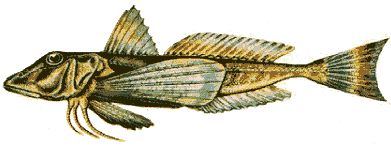
Trigla lucerna Linnaeus, 1758

Synonyms: Trigla hirundo Bloch, 1758; Trigla corvus Risso, 1826; Trigla poeciloptera Cuvier, 1829; Trigla corax Moreau, 1881; Trigla lucerna LeDanois, 1913; Chelidonichthys lucernus Richards, 1988
Common names: Bulg: Morska lystovitsa; Georg: Zgvis citeli mamali; Rom: Randunica de mare; Turk: Kirlangic; Russ: Morskoy petukh
Order: SCORPAENIFORMES
Family: TRIGLIDAE
Taxonomic descriptions: A conical body, the head is completely covered with more or less spiny bony plates and the three lower rays of the pectoral fins are completely free from the interradial membrane. The lateral line is smooth, without enlarged bony scales. The snout terminates in two small lobes armed on their external margin with spines and separated by a shallow notch. Behind the head and immediately above the pectoral fin there is a broad coracoid spine which is as long as the eye diameter. Back and sides are of dull red or reddish-brown colour, belly white, pectoral fins purple-red on the external side, inner side blue with a circular blackish patch. Size: maximum - 65 cm; common - about 30 cm.
 IUCN Status:
IUCN Status:
World level:
Black Sea Regional level:
Subregion level: VU
Distribution:
Habitats type, Critical habitats, Limiting factors: Bottom species occurring over sand, muddy-sand or gravel at depths from 5 to 200 m, but it is more common between 50 and 100 m. It is very common in the Mediterranean and the Sea of Marmara, present in the eastern Atlantic from the British Isles to the coast of Senegal. Pollution, hypoxia are limiting factors.
Biology: Feeds mainly on crustaceans, mostly decapods, but also fishes and molluscs; spawning from December till July, with maximum intensity in June-July; pelagial eggs, spherical in shape, with a large fat drop.
Population trends: A rare species, caught with bottom trawls but also with long-lines and band lines. The species constitute a separate statistical category only in Turkey, in the other countries it is included in larger statistical categories, being rare in catches. On the Turkish coasts catches were 80 t (1989), 60 t (1990) and 112 t (1991).
Threats: Hypoxia, pollution.
Conservation measures taken: None.
Conservation measures proposed: Reduce eutrophication/pollution.
References:
Compiled by: A.Petranu